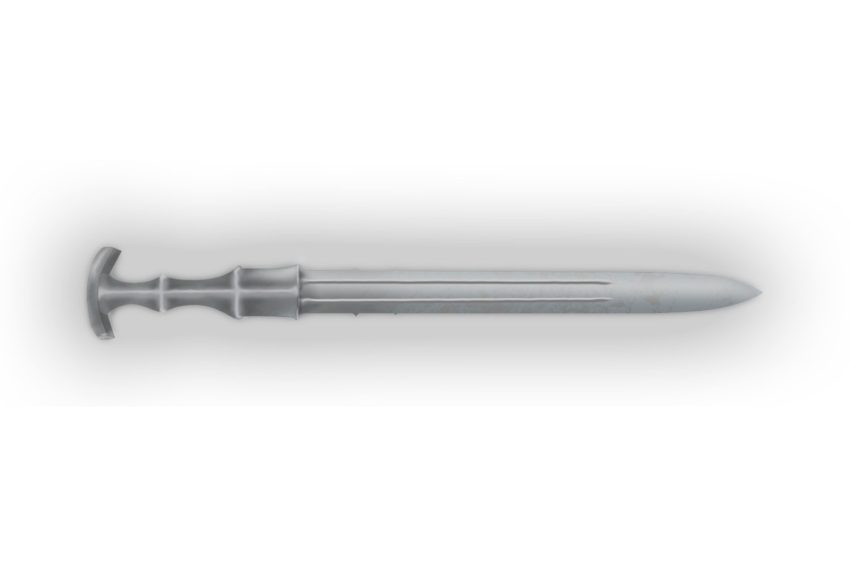The Japanese tsurugi sword is one cloaked in legends and myths integral to the very soul of Japan. Very little is documented about the particular character and creation of this legendary sword, but what has been recorded tells a story of the origins of Japan and the beginning of a tradition of excellence in swordsmanship and war.
What is a Japanese Tsurugi Sword?
When first introduced many centuries ago, the Japanese tsurugiTSURUGI 剣 "sword [non-Japanese]" learn more... sword was an anomaly in Japanese sword design: it had two edges rather than one. Tsurugi are commonly thought to have been modeled after the popular Chinese jian, another type of two-edged broadsword.
Ranging from 35 inches to 39 inches long, tsurugi swords were much longer than the later katanaKATANA 刀 "sword" learn more.... The handle was also traditionally 8 inches long. Unlike the common image of a Japanese sword, with an elegantly curving blade, the tsurugi always had a long, straight, sometimes stylized blade with no curve. Stories indicate that the first tsurugi would have been made of stone, before bronze and iron were used for stronger, more versatile blades.
History of the Japanese Tsurugi Sword
The Japanese tsurugi sword was based on another long broadsword, the Chinese jian. Chinese jian swords were used for around 2,500 years in China and were a popular weapon for war and swordsmanship. It is likely that interactions between Japan and China in ancient times led to the adoption of a sword similar to the jian. The tsurugi would have originated in the Bronze Age, meaning this sword is one of the oldest known in Japan. Little is therefore known about the specific use of tsurugi, besides the ultimate link to the divine and the power of the gods.
If little is known about the creation of the tsurugi sword, then even less is known about how they fell out of favor. These swords appear in the mythology of Japan, but perhaps gave way to more beautiful, unique blades. As new techniques of swordmaking arose in Japan, two-edged swords were primarily replaced by the ubiquitous single-edged, curved katana.
Tsurugi Swords for Collectors
An original tsurugi is basically impossible to find nowadays. You could look, but even if you somehow found one in decent condition, you would probably be obligated to donate it to a museum. At the urging of the Japanese government, no less. They would happily (and forcefully) take any Bronze Age swords off your hands.
Keep in mind that the Japanese tsurugi sword appeared in incredibly ancient Japanese texts, fables which speak of monsters and divine power. It just might be for the benefit of you and everyone else around you that there is virtually no possibility of ever wielding a true tsurugi sword.
Modern Tsurugi Reproductions
As mentioned, due to there being few original tsurugi swords to model a reproduction after, you will have an interesting time locating one to purchase for your personal collection. But all is not lost for you: consider looking for reproductions of the most famous Japanese tsurugi sword, the Kusanagi.
If you’re really set on owning a tsurugi, you can attempt to commission a custom-made tsurugi sword from a reliable manufacturer.
Famous Japanese Tsurugi Swords
While there are no tsurugi available to buy as a private collector, these swords appear in integral stories of Japan’s past. There may or may not be one famous, real, original tsurugi left in all of Japan.
Kusanagi-no-Tsurugi: The Excalibur of Japan
The name Kusanagi-no-Tsurugi translates literally to “Grass-Cutting Sword,” but in legends this sword did much, much more than help mow the Emperor’s lawn. The sword’s original name, while a bit longer and less flowing, sounds a bit more grand in translation: Ame-no-Murakumo-no-Tsurugi (“Heavenly Sword of Gathering Clouds.”) The Kusanagi is one of three objects that make up the Imperial Regalia of Japan; it represents the virtue of valor.
The Legend of the Eight-Headed Serpent
Legend says that a monstrous, eight-headed serpent known as Yamata-no-Orochi began to terrorize a wealthy, influential family in the Izumom province of ancient Japan. Seven of the family’s eight daughters had been consumed by the massive creature before the family went to ask aid from Susanoo, the powerful god of seas and storms.
Even the mighty god was unable to defeat the serpent without a plan and decided to get each of its eight heads drunk on sake, the famous Japanese rice wine. Once the serpent was intoxicated on the tasty liquor, Susanoo promptly decapitated each head. (It’s definitely a tale warning against the dangers of intoxication.) And from the tail of creature, Susanoo found the Kusanagi-no-Tsurugi. In the legend, however, Susanoo wouldn’t keep the sword, but instead give it to his more powerful sister, Amaterasu, the goddess of the sun.
Two ancient Japanese texts continue the tale of the Kusanagi: the Kojiki (“Records of Ancient Matters”) and the Nihon Shoki (“Chronicles of Japan.”) Myth holds that the sun goddess then gifted the divine sword to the son of Emperor Keiko, Yamato Takeru. Under the prince’s possession, the sword received a new moniker when he cut down burning grass sent by a menacing rival. Yamato learned that his new sword could control the wind and used it to push the fire back towards his enemy.
See now why authentic tsurugi have tended not to survive, or possibly even not to have ever existed?
The Real Kusanagi
So you’re probably thinking that this type of sword could really only exist in myths and anime stories. However, a fairly reliable record of ancient Japanese history notes that a sword known as the Kusanagi-no-Tsurugi was placed in the Atsuta Shrine around 686 AD. By this time, people said the sword was cursed and may have been the cause of the untimely death of the Emperor Tenmu. While you might think such a curse would require a Tolkienesque quest to destroy the sword in a fiery volcano, it was still an object of extreme importance to the legitimacy of the Japanese emperors due to its links to the gods.
Nowadays, no one alive has actually laid eyes on the supposed sword known as Kusanagi-no-Tsurugi. It was last removed from its place in the Astuta Shrine in 1989 at the last coronation ceremony of Emperor Akihito. The sword was completely wrapped and covered to avoid causing anyone to lay eyes on it a violent, awful death.
Real or Replica?
A final legend of the Kusanagi-no-Tsurugi is the origin of the debate over the originality of the Kusanagi-no-Tsurugi apparently kept safe at the Astuta Shrine. The Tale of the Heike describes how the Emperor at the time jumped into the sea to commit suicide after being defeated in 1185 at the Battle of Dan-no-ura. The Kusanagi, like a famous European sword, would be lost forever to the water. Another story, however, has the sword washing up on a beach in the city of Ise where it could have been taken by priests into safe-keeping.
Tsurugi: Powerful and Mysterious
Fans of the tsurugi sword and the legends shrouding their origin will love how frequently it has entered into pop culture. Various video games, like Okami and the Final Fantasy series, have the famous Kusanagi-no-Tsurugi apppear during gameplay, and of course the sword pops up in the world of Naruto.
Additionally, the coronation of the Emperor Reiwa in October 2019 will perhaps be the last opportunity in a long while to get a glimpse of the famous Kusanagi sword, as well as the other objects of the Imperial Regalia.

